Stan VanDerBeek: Newsreel of Dreams
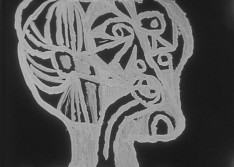
film still from Mankinda courtesy of The New American Cinema Group, Inc, The Film-Makers' Cooperative
Thursday, September 10, 2015, 7pm
Los Angeles Filmforum at MOCA presents
Stan VanDerBeek: Newsreel of Dreams
Introduced by Gene Youngblood!
MOCA Grand Avenue, 250 South Grand Avenue, Los Angeles CA 90012
Insatiably curious and eternally optimistic about the ever-moving horizons of moving image making, Stan VanDerBeek experimented with nearly every means available of creating and combining pictures. From collage film and cut-out animation to early explorations of large-scale film installation and the front-lines of electronic image-making, VanDerBeek enthusiastically embraced evolving technologies and their potential for new experiences. Trained at Black Mountain College, where he was influenced by figures such as John Cage, Merce Cunningham, and Buckminster Fuller, VanDerBeek saw the potential in each new tool for expanding communication and immersion, often joyfully combining forms—photography, film, music, video, computer, dance, et al.—to arrive at unique syntheses and interdisciplinary projects. According to Gene Youngblood, he was a visionary of “the cultural and psychological implications of the Paleocybernetic Age.” Los Angeles Filmforum at MOCA is proud to present a program of VanDerBeek’s films in connection with the work of artists associated with Black Mountain College currently on view in the permanent collection with an introduction by Gene Youngblood via streaming video. —Madison Brookshire
INFO education@moca.org or 213.621.1745
TICKETS $12 general admission, $7 students with valid ID
FREE for Los Angeles Filmforum and MOCA members
Tickets available in advance at http://www.brownpapertickets.com/event/2194689
Stan VanDerBeek (1927-1984) studied art at The Cooper Union for the Advancement of Science and Art, New York, and at Black Mountain College, Asheville, NC (1949-1951). During his lifetime, his work was featured in numerous exhibitions and film festivals internationally. Recent exhibitions that have featured VanDerBeek's work include Gwangju Biennale (2010); Stan VanDerBeek: The Culture Intercom, MIT List Visual Arts Center, Cambridge, MA and Contemporary Arts Museum Houston (2011); Ghosts in The Machine, The New Museum of Contemporary Art, New York (2012); and Venice Biennale (2013). Upcoming exhibitions include Leap Before You Look: Black Mountain College 1933-1957, The Institute of Contemporary Art, Boston; Hammer Museum of Art, Los Angeles; Wexner Center for the Arts, Columbus, OH (2015-2017).
Gene Youngblood (1942-) is a theorist of media arts and politics, and a scholar of alternative cinema history and theory. As a journalist in the 1960s he covered the counterculture and The New American Cinema, first for the mainstream Los Angeles Herald-Examiner, then for the “underground” Los Angeles Free Press, and he hosted a weekly radio program on those subjects for KPFK. In 1970 he published the influential book, Expanded Cinema, and became a founding member of the faculty of Critical Studies at California Institute of the Arts. He is currently working on several multimedia projects, including the video diaries of George Kuchar and the career of social networking pioneers Kit Galloway and Sherrie Rabinowitz. A documentary about Youngblood’s work in radical media politics, Secession From the Broadcast, is currently in production.
Programmed by Madison Brookshire
Acknowledgements:
Digital files courtesy the Estate of Stan VanDerBeek and Canyon Cinema.
Los Angeles Filmforum at MOCA is supported through both organizations by the Los Angeles County Board of Supervisors through the Los Angeles County Arts Commission. Additional support of Filmforum's screening series comes from the Department of Cultural Affairs, City of Los Angeles, the Mike Kelley Foundation for the Arts and Bloomberg Philanthropies. We also depend on our members, ticket buyers, and individual donors.
Los Angeles Filmforum at MOCA furthers MOCA’s mission to be the defining museum of contemporary art with a bimonthly series of film and video screenings organized and co-presented by Los Angeles Filmforum—the city’s longest-running organization dedicated to weekly screenings of experimental film, documentaries, video art, and experimental animation.
For more on Los Angeles Filmforum, visit lafilmforum.org, or email lafilmforum@yahoo.com. For more information on MOCA, visit moca.org.
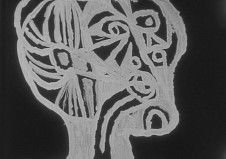
Mankinda
Mankinda
By Stan VanDerBeek
1959, 16mm film transferred to video, black and white, sound, 10 min.
Mankinda is an experimental combination of verse and hand-painted images creating graphic as well as verbal excitement. The letters themselves assume an almost ideographic significance. Vanderbeek described this film as a "visual tunnel, with a poem carved in light upon walls."
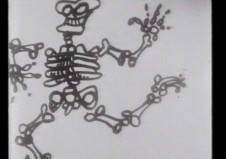
Breathdeath
Breathdeath
1964, 16mm film transferred to video, black and white, sound, 15 min.
Dedicated to Charlie Chaplin and Buster Keaton. A surrealistic fantasy based on the 15th century woodcuts of the dance of the dead. A film experiment that deals with the photoreality and the surrealism of life. It is a collage-animation that cuts up photos and newsreel film and reassembles them, producing an image that is a mixture of unexplainable fact (Why is Harpo Marx playing a harp in the middle of a battlefield?) with the inexplicable act (Why is there a battlefield?). It is a black comedy, a fantasy that mocks at death ... a parabolic parable.
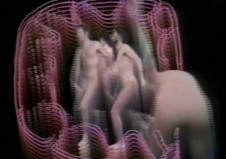
Newsreel of Dreams, Part 1
Newsreel of Dreams, Part 1
1964, 16mm film transferred to video, color, sound, 8 min.
Dream matrix, history written in lightning image, memory and the TV syntax, images flowing and fused together to other images and electronic tapestry of images half seen, sought for, seeking man's dreams, movies as dreams, history as media.
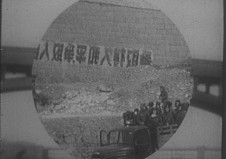
film still from Panels for the Walls of the World courtesy of The New American Cinema Group, Inc, The Film-Makers' Cooperative
Panels for the Walls of the World
1967, 16mm film transferred to video, black and white, sound, 8 min.
An experiment in videotape control, an electric collage that mixes the images by way of electronic mattes, superimpositions, and other electronic means of integrating as many as eight separate images onto one screen. A film commissioned by CBS for TV, it is the first such attempt to examine the almost unlimited graphic and visual possibilities of videotape intermix.
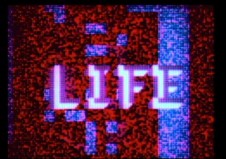
Poemfield #2 Courtesy of Electronic Arts Intermix
Poemfield No. 2
1966, 16mm film transferred to video, color, sound, 6 min.
COMPUTER ART SERIES is animated computer/graphic films. The series is called POEMFIELD. All of these films explore variations of poems, computer graphics, and in some cases combine live action images and animation collage; all are geometric and fast moving and in color. There are eight films in the computer animated art series. As samples of the art of the future all the films explore variations of abstract geometric forms and words. In effect these works could be compared to the illuminated manuscripts of an earlier age. Now typography and design are created at speeds of 100,000 decisions per second, set in motion a step away from "mental movies. Colorized by Brown and Olvey.
Poemfield No. 5
1968, 16mm film transferred to video, color, sound, 6.5 min.
Realized with Ken Knowlton
Soundtrack: Computer generated
Poemfield No. 7
1967-8, 16mm film transferred to video, color, sound, 4 min.
Calligraphic computer animation of the enigmatic poem “There is no way to peace-Peace is the way.” Black and white animation is colored by Brown/Olvey. This film with soundtrack by John Cage is a lyric accidental stylization of Christian myth/crosses. The patterns are written by random programs on a computer with help by Ken Knowlton.
Film Form #1
1968, 16mm film transferred to video, color, sound, 11 min
Danced by Adrienne Egan and Jane Baird Adam
A hypnotic dance film of colors, dancers, forms and music all sweeping through the tv tube eye, mixed together into a flow of female bodies and colors, a brilliant study of color printing from black and white.
Newsreel of Dreams, Part 2
1970, 16mm film transferred to video, color, sound, 8 min.
A video/graphic collage of old newsreel footage synthesized with color and superimpositions to produce vision of history as dream-events that look like history but disappear inside each other. Each film is part of an endless series of newsreels of dreams to include any found fil and present newsreel footage.
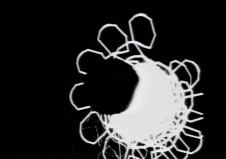
Symmetricks, Courtesy of the Estate of Stan VanDerBeek
Symmetricks
1972, 16mm film transferred to video, black and white, sound, 7 min.
Computer-animated drawing that works at the speed of light. Developed as an experiment at MIT while at the Center for Advanced Visual Studies, this film explores the rapid tracking of drawn line images compounded by the symmetry of multiple images; one result of the experiment is the phenomenon of color that comes from the black and white images, a blend of music and images that mystifies and delights the eye.
